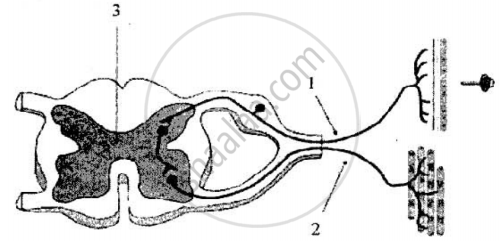Advertisements
Advertisements
Question
The diagram given below shows the internal structure of a spinal cord depicting a phenomenon. Study the diagram and answer the questions:

1) Name the phenomenon that is depicted in the diagram. Define the phenomenon.
2) Give the technical term for the point of contact between the two nerve cells.
3) Name the parts numbered 1, 2 and 3.
4) How does the arrangement of neurons in the spinal cord differ from that of the brain?
5) Mention two ways by which the spinal cord is protected in our body.
Solution
1) Reflex action
Definition - A quick, automatic, involuntary and often unconscious action brought about when the
receptors are stimulated by external or internal stimuli.
2) Synaptic - Junction
3)
- 1 = Sensory neuron
- 2 = Motor neuron
- 3 = Grey matter with the central canal of the spinal cord
4) The grey matter is present in the cortex (outer side) consisting of cell bodies and white matter is present inside, which consists of myelinated axons in the brain.
In the spinal cord, the grey matter (cell bodies) are present inside, while white matter (Myelinated axon) is present outside.
5) The vertebral column, meninges and cerebrospinal fluid (CSF).
APPEARS IN
RELATED QUESTIONS
Name one gustatory receptor and one olfactory receptor present in human beings.
Differentiate between natural reflex and conditioned reflex. Give examples to illustrate your answer.
Define voluntary and reflex actions. Give examples of each.
State whether the following is
Constriction of pupil
Give Technical Term:
Response to a stimulus without the intervention of the will of an animal.
Complete the following sentence with appropriate Word
The control of reflex action is through:
Differentiate between Voluntary and involuntary actions.
The reflex arc which is made up of one sensory and one motor neuron is ______
Which of the following is not an involuntary action?
If after cutting through dorsal root of a spinal nerve of a mammal, the associated receptor in skin was stimulated the animal would ______.
